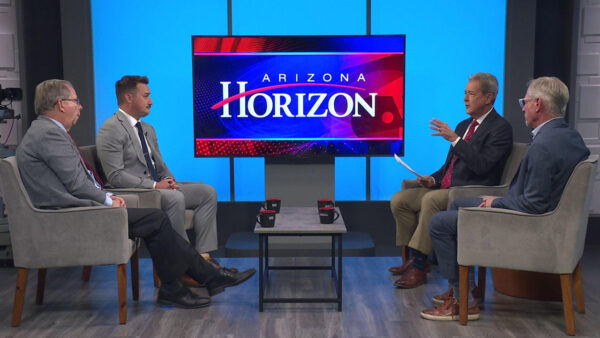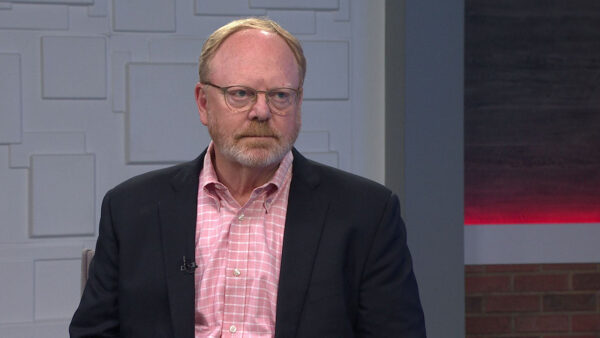Federal stimulus dollars are providing a huge financial lift to a program that helps low income Arizonans save money on their utility bills while making their homes more energy efficient. We’ll take a look at this program that saves energy, lowers utility bills, makes homes safer, and keeps people employed.
TED SIMONS: Arizona's getting millions of dollars from the federal government to expand a program that helps low income people remain in their homes by cutting their utility bills. As David Majure reports, the program is also creating jobs.
DAVID MAJURE: High energy bills are a pain for a lot of people, but they're a problem for those who simply can't afford them.
SHIRLEY HERNANDEZ: Last year my highest bill was over $800, like $829.
DAVID MAJURE: During the summer Shirley Hernandez was paying an average of three to $400 a month for electricity. That's a fortune for a single mom on a fixed disability income of almost $1,800 a month, with a thousand dollar mortgage payment.
SHIRLEY HERNANDEZ: It was either pay my house payment or pay my electric bill. I'm a payment behind on my house, because it was too hot. Too hot.
DAVID MAJURE: Technicians from the foundation for senior living are trying to make Shirley more comfortable and save her some money. They recently did an energy audit on her house looking for ways to make it more energy efficient. Using the latest technology they measure how air tight the house is, then they track down leaks that make air conditioners work harder.
MAN: Watch the air just go right out the door.
DAVID MAJURE: It's all part of the U.S. Department of Energy's Weatherization Assistance Program. In Arizona it's administered by the State Department of Commerce.
CHARLIE GOHMAN: A large percentage of the clients are either elderly, on fixed income, disabled, but now we're seeing a lot more people that are unemployed, you know, losing their jobs, but historically it's been elderly,disabled, people on fixed incomes. An average person might pay five, 6% of their income on utility costs, for a lot of the low income people they're paying 20, 25%.
MAN: 3580.
DAVID MAJURE: The program's been helping low income Arizonans for decades, but it's never had the funding it has now. Over the next three years the federal stimulus plan will pump $57 million into this program that had been operating on less than $5 million a year.
CHARLIE GOHMAN: We're expanding the amount of work that we can do probably by a factor of 10.
That means going from 800 homes a year to 8,000 or more in the next three years. All of that work requires many more workers.
CHARLIE GOHMAN: So that's the biggest thing is just we have to go out and ramp up so we're doing an awful lot of training.
MAN: What this reading means --
DAVID MAJURE: The training takes place at the foundation for senior living's training center in Phoenix. In the past it trained about five people every two months. Now it's training more than 30 a month, putting a lot of construction workers back to work doing home energy audits.
CHARLIE GOHMAN: And that's what this stimulus is really doing, we're training a lot of people, putting a lot of people to work in a really important industry.
DAVID MAJURE: Back at Shirley's house the technicians have identified a number of problems including leaky air ducts and an air conditioner that needs replacing.
VINNY PEDALINO: So we anticipate phenomenal savings in this house, sealing duct work and replacing air conditioning systems, just that even though we'll do more than that, those are the big things, duct leakage is probably the number one most cost effective thing.
DAVID MAJURE: The weatherization program will pay for those repairs as long as they're cost effective.
CHARLIE GOHMAN: The common things we do are the duct sealing. Air sealing, sealing up all the holes between the house and the outside. You know, insulating the attic, shade screens on windows, we do an awful lot of replacing equipment.
DAVID MAJURE: On average for every dollar spent the program generates $1.30 in savings, Shirley should see a difference on her utility bill after all the work is done.
VINNY PEDALINO: It's hard to make predictions on this stuff, but I'm pretty confident we're going to cut her bill in half if not a lot more than that.
SHIRLEY HERNANDEZ: You're out of here? Ok bye, you guys, thank you very much.
SHIRLEY HERNANDEZ: I'm blessed. I don't want to lose my house, so thank God, I didn't know what I was going to do.
TED SIMONS: The weatherization program is available for people with incomes up to 200% of the federal poverty level, $40,000 a year for a family of four. More information is available on Arizona Department of Commerce website at azcommerce.com. Look for the link to energy programs.























